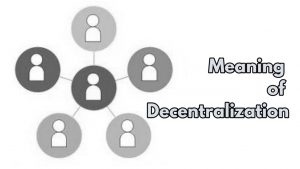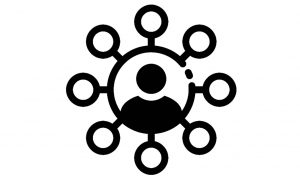Differences between centralization and decentralization: Centralization and Decentralization has two heads; the management control system of an organization and the nature of decision making that is available for a country to use.
In relation to the control system of a company or organization, Decentralization is the distribution of power among lower and middle management. Here decision making powers are delegated to departmental, divisional, unit or center level managers, and this is happening at all levels of the organization. Decisions are divided into subgroups, and there is swift communication between this subgroups.
In Centralization, however, all power and authority is upheld at the topmost level. In centralized organizations only the executives make the important decisions, and it is used in small organizations. However, it must not only be used for small organizations. Example, Apple, a tech company popular for it’s phones and laptops which was previously run by Steve Jobs, and is now run by Tim Cook, has executives that maintain a strategic decision over new product development, markets to operate in, and company aquisitions, even though it’s one of the biggest companies in the world today.

Recommended: Advantages and Disadvantages of a written constitution
This deals mostly with the formal authorities in the organization. It is a management control system and is very important to an organisation. It requires forward-looking (strategic planning) and backward-looking (evaluating what has occured). This management system was mostly practiced in ancient times.
Modern companies employ the two techniques, leaning towards one or the other, but usually they have control techniques in order to strike a healthy balance. Generally inadequate or restricted control by the workers leads to centralization and adequate control leads to Decentralization. A key factor that determines the level of Decentralization however is the significance of the decision. This decisions are made in a centralized manner in order not to ruin the very fabric of the the company or business.
The key points in this two concepts is the difference in decision making and the issue of where in the hierarchy of the organization does this burden of decision making lie.

The main importance is that it helps everyone know what role they are going to play, whether as decision makers or mere workers in the organization.
Recommended: List of countries that has an uncodified constitution
Control techniques:
a. In most organizations, senior management believes everything must have a uniform aspect. This however deters the regions from making decisions about key aspects of the economy.
b. In Decentralization, juniors are trained instead of giving them any specific type of training.
To known which one the company is using, either of the following should be saught after.
1. The place of decision making: Is it happening at the higher or lower level of the organization?
2. The degree of decision making: Who has more say? Higher or lower level.
The key features of the two systems are as follows:
Decentralization:
a. In Decentralization there is spread of both power, responsibility and accountability to various management levels.
b. It is mostly used for large firms and businesses.
c. It is mostly used where the business is in a highly competitive industry and needs to adapt quickly.
d. It occurs in a business with few employees.
e. Open and free communication is a key feature in Decentralization.
f. There is often no pattern to decision making.
Also see: How to become a successful business entrepreneur
Centralization:
a. In Centralization flow of communication is upright, so others must follow the decisions of the executives or senior management and decision making is then time consuming.
b. Whenever the executives have inadequate control, then a hierarchical structure is used. Such that, if the CEO isn’t available, the deputy does it. If the Vice Chancellor isn’t available, the Dean does the job, etc. There is a reservation of authority that is systematic and consistent, involving hierarchy.
c. There is retention of power, decision and planning in the top level only.
d. Companies that pay strict attention to the mission and vision of the company use centralization.
e. Centralization occurs in a company or business with high number of employees.
f. The authority is consistent and there is pattern to decision making.
Recommended: Key differences between Law and Morality
Advantages of Centralization:
Despite having the decision making powers only in the hands of a few, centralization does have its advantages namely:
1. The organization enforces procedures and policies, and that’s what everybody obeys and standsby
2. Saves costs; eliminates too much activities.
3. Control is more with the senior executives who have more skill and expertize.
4. There is clarity in decision making.
Disadvantages:
Centralization is, of course, not without its problems. Below are some disadvantages:
1. In centralized organizations, the employees have less closer source of action and information.
2. A great disadvantage of Centralization is that the burden of responsibility rests with the apex, an others may barely even be noticed. The junior staff function merely as stooges to the seniors.
3. It also leads to employee demotivation.
4. In Centralized systems there is too rigid and too formal communication between he employee and the employer making it a time consuming process.
Also see: How to hold a long conversation with a girl
Advantages of Decentralization:
1. Flow of communication is easier
2. Decision making process is faster.
3. Lower management decides when, where and how to work. Positioning in the company is not done by the upper echelon but by where the people can work.
4. This is implemented in large size organizations.
5. It reduces the amount of burden and responsibility among the lower grade class by having the upper grade dictate their life for them.
6. It helps the company have better competitive advantage.
Disadvantages of Decentralization:
1. It results in inefficiency. Since decision making is delegated there is always a problem with coordination.
2. It results in inefficiency.
3. It can result in the company having incongruous results from the many decision makers
4. It can make departments in the organization to be self centered. This means that they don’t make decisions that benefit the whole organization but their department.
Recommended: How to be a good conversationalist
Top 7 Major Differences Between Centralization and Decentralization
1. In Centralization all power and authority is upheld at the topmost level. While in Decentralization power and authority is upheld by the middle or lower management.
2. In Centralization communication is vertically aligned. While in Decentralization there is no alignment, free breakdown of all communication and more options.
3. In Centralization: decision making process is slow since that comprises only the upper echelon. While in Decentralization decision making is faster.
4. Centralization does not possess proper control over the organization while Decentralization possesses proper control over the organization.

Also see: Ways of promoting popular participation in politics
5. Centralization is used in small sized firms while Decentralization is used in large sized firms.
6. Centralization deals with the holding of power by the top at Central points. While Decentralization deal with delegation.
7. As regards planning: Senior management in Centralization control the planning processes of the organization. In a company it would be the CEO or managers. In a University it would be the VC, register, Dean. While in Decentralization planning is left to the middle management or lower management: e.g. the Heads of Department, Professors, head Lecturers, Deans secretary. For companies supervisors etc.
Recommended: Advantages and Disadvantages of division of labor
Factors determining the degree of Decentralization:
1. Significance of the Decision: A key factor that determines the level of Decentralization however is the significance of the decision. This decisions are made in a centralized manner in order not to ruin the very fabric of the the company or business.
2. Size of the Enterprise: This determines the degree of Decentralization, the number of departments and levels and it helps to avoid delay in large organizations.
3. The Attitude and Philosophy of the Management: The attitude of senior management is of two types:
1. The traditional mindest: Executives take the advice of the workers.
2. The rational managerial temperament: Here, executives use purely Decentralization, such that they even take the decisions of the workers sometimes and join it with their own decisions.
A discussion of Decentralization and delegation will suffice here: Decentralization is about Philosophy of the organization while delegation is handing part of authority to subordinate personells or groups.
Centralization is a choice while delegation is must. Delegation even happens between the higher-ups.
Recommended: Characteristics of a good constitution
Centralization and Decentralization in Government
In Centralization different levels are made and each level has a certain authority of taking decisions related to a particular area. Centralization is often dictatorial and authoritarian. Denmark and Norway aren’t military or authoritarian in nature but still they use a centralized system.
Advantages:
a. Budget utilization.
b. Focused Vision.
c. Establishes a common goal for the whole society.
d. It is efficient
e. Doesn’t envolve duplications of decision
In a Decentralized state decision making may be implemented differently. Autonomy of regions and local authorities varies a lot. In democracy for instance, according to the constitution; in military rule, according to the decrees of edicts. China and Us are good examples.
Advantages
a. It reduces risk of dictatorship or over concerntration of powerd at the center.
b. Enhance economic development.
c. Ensures political participation.
f. Promotes the creation of good policies.
Also see: Reasons for delegation of power
In conclusion, for a Decentralized structure to be successful, the organization must empower employees to develop exercise, innovate, and collaborate to achieve its goals. New businesses, which are small, have employees who are involved in the day-to-day running of the business. Daily decisions are ongoing. Specific and strategic decisions are done by the Chief Executives. Since it’s a small organization the business owners can be involved in the daily decisions like the case of Johnson & Johnson when it first started with just 14 employees (its first factory).
If the team weren’t able to come together to make notable decisions, then they wouldn’t have grown to be able to have 125,000 associates and operating in over 60 countries. If all the decisions were put on the owners head he wouldn’t have been able to make decisions that would help the growth to that extent. While centralization and Decentralization is specific to different organizations, any organization can choose the one that bests fits them or they think will be ok for a particular point in time, flexibility is allowed here.
Whereas Centralization was used mostly in the aincent times; Decentralization is used with increasing organizational complexity. Full concerntration in centralization isn’t good because it means that power would be left in a few hands and can be even intoxicating. On the other hand, over Decentralization can lead to inability to control supervisory and managerial activities. There should be a healthy balance between the two.
My take on this matter is that a company or country should be equipped with the two of them. Complete centralization results in turning workers to slaves. Full Decentralization will make the executives lose control over the whole system.

Edeh Samuel Chukwuemeka, ACMC, is a lawyer and a certified mediator/conciliator in Nigeria. He is also a developer with knowledge in various programming languages. Samuel is determined to leverage his skills in technology, SEO, and legal practice to revolutionize the legal profession worldwide by creating web and mobile applications that simplify legal research. Sam is also passionate about educating and providing valuable information to people.